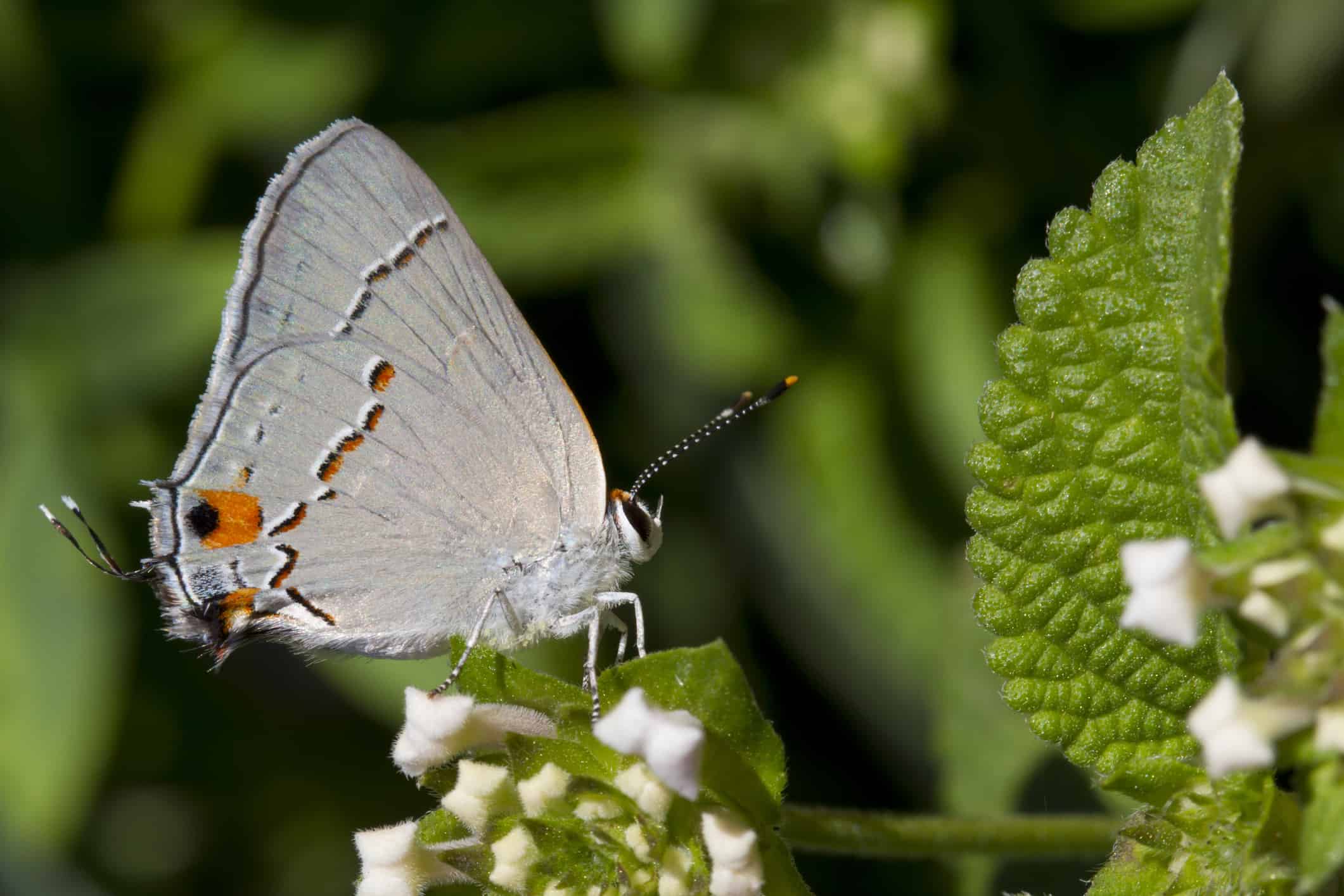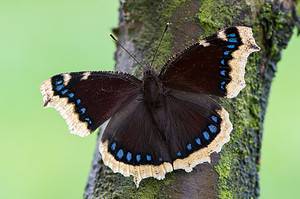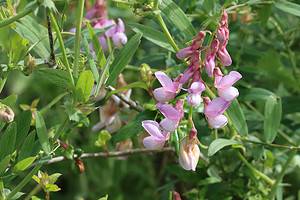Are you fascinated with butterflies? They are unique creatures with colorfully patterned wings fluttering through the air. In California, you can spot them around flowers or even see them migrating across North America in the summer. But do butterflies impact our ecosystem? Absolutely!
Butterflies help pollinate plants as they feed on nectar. There are more than 700 butterfly species in the United States, and 170 can be found in California alone. This is because California’s warm climate makes it perfect for breeding butterflies. There are also lots of wild lilacs and asters that most butterflies love to eat. Without further ado, here’s a roundup of some of the incredible butterflies that live in California.
1. Variable Checkerspot
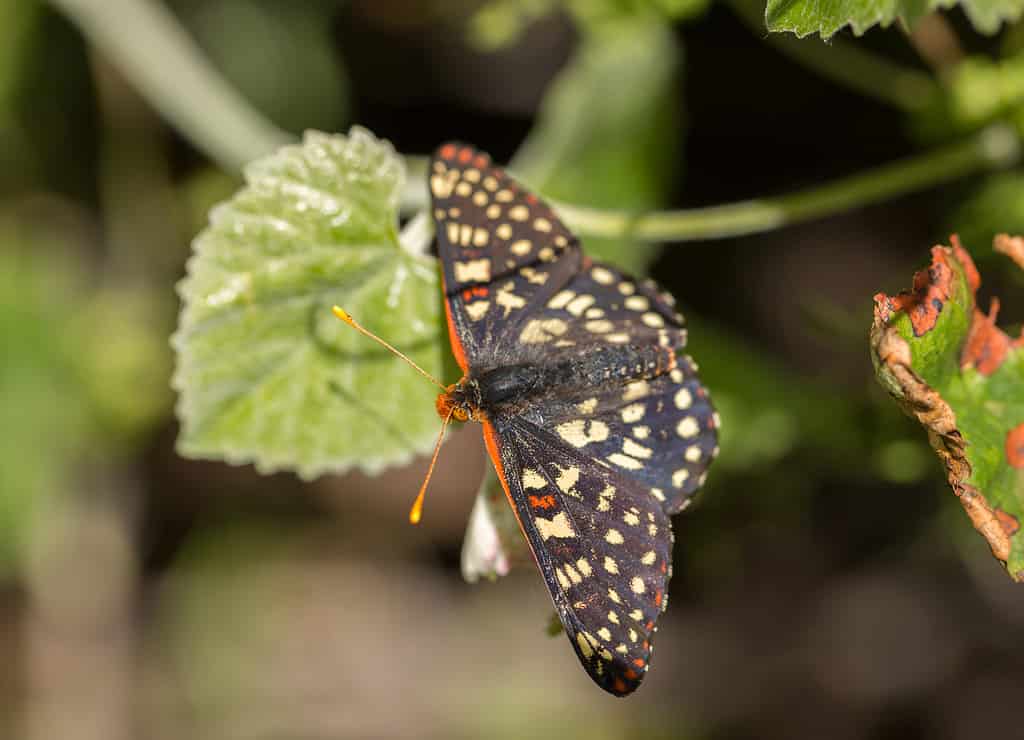
Variable checkerspot butterflies can be found in California, the Rocky Mountains and throughout North America.
©iStock.com/yhelfman
Also known as Euphydryas chalcedona, the variable checkerspot is one of the dark-colored butterflies in California. The butterfly has black wings with red and black margins on the edges and white spots across. The uniquely patterned wings allow the butterfly to avoid predators such as birds. It has a wingspan that ranges between 1.3 and 2.2 inches.
Before turning into a butterfly, the variable checkerspot feeds on local plants, such as yerba santa, while it’s still a caterpillar. The species feeds on local sticky monkey-flowers in California during its larval stage.
The variable checkerspot can keep its predators away during its larval stage by absorbing toxins from flowers, which give it a sour taste that repels predators. Adult butterflies survive on nectar. You can spot the butterfly in various reserves within California and on different plants nationwide.
2. Gray Hairstreak

Gray hairstreak butterflies are widespread throughout North America.
©iStock.com/jamesdvdsn
Known scientifically as Strymon melinus, the gray hairstreak has a long thin wing tail that looks like hair. The tail-like structure is a defense mechanism that helps distract predators and protect the butterfly. The wingtail appears like an antenna, and the spots on the butterfly’s wings appear like eyes, confusing predators about what kind of strange creature it could be.
It has slate gray wings with bright orange spots at the bottom. Black and white stripes on the edge also characterize the wings. The wingspan is 1 to 1.5 inches long. You can spot the gray hairstreak butterfly in unused pastures, rural meadows, or roadsides.
3. American Lady
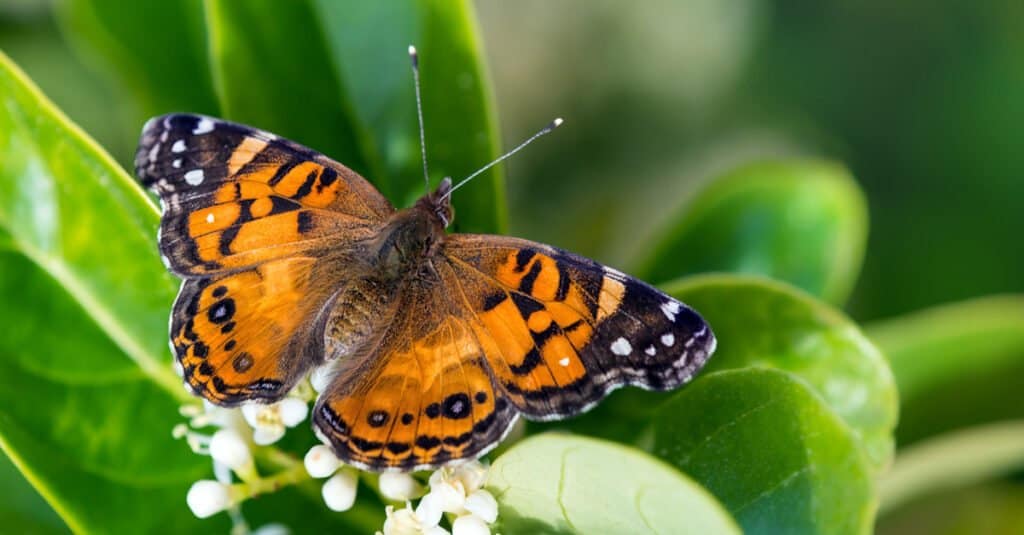
The American lady butterfly is also known as the American painted lady.
©iStock.com/leekris
The American Lady butterfly, also known as Vanessa virginiensis, is a brilliantly colored orange butterfly known for its nervous nature. The butterfly always takes flight whenever the slightest disturbance occurs. Its orange wings are marked with purple and white spots, while the edges have dark borders. The under wings of the American Lady butterfly have ornate patterns that resemble a cobweb.
You can also spot circular markings similar to eyespots on the butterfly’s underside wings. The eyespots are meant to intimidate predators and ward off danger. The wingspan of the American lady butterfly is between 1.75 and 2.5 inches long.
The primary food source for the butterfly is nectar obtained from flowering plants like common milkweed, marigold, aster, and dogbane. In larvae form, Vanessa virginiensis feeds on green plantains such as ironweed and wormwood.
If you want to spot the American lady butterfly in California, check out open landscapes with leafy plants that grow flowers.
4. Mourning Cloak
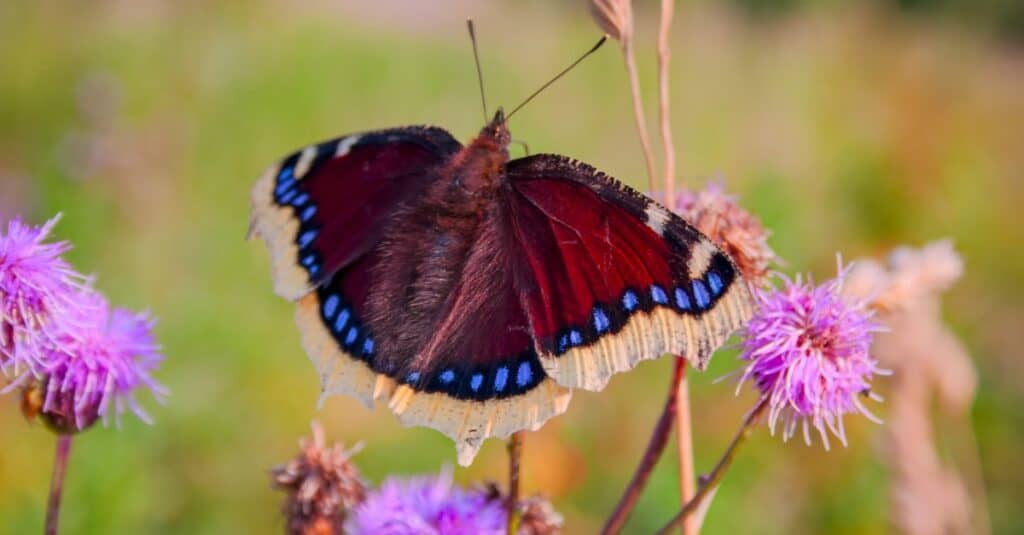
Mourning cloak butterflies are some of the most beautiful species in California.
©iStock.com/Anatoliy Berislavskiy
The mourning cloak butterfly is known scientifically as Nymphalis antiopa. It’s known for its distinct black wings with a shimmering glaze. The wings are lined with a yellow border and contain rows of purple spots towards the edge. Its wingspan is 3 to 4 inches.
This butterfly escapes danger by folding its camouflaged wings in the presence of predators. It is a species that can survive for a long time because it can live up to 10 months. However, spotting the Mourning Cloak butterfly is rare since it loves solitary habitats. Though, if you are dedicated to your mission of watching and studying butterflies, you can find this species in golf courses, isolated parks, and desolate yards. You can also spot the butterfly in areas surrounding deciduous forests.
5. Eastern Tailed-Blue
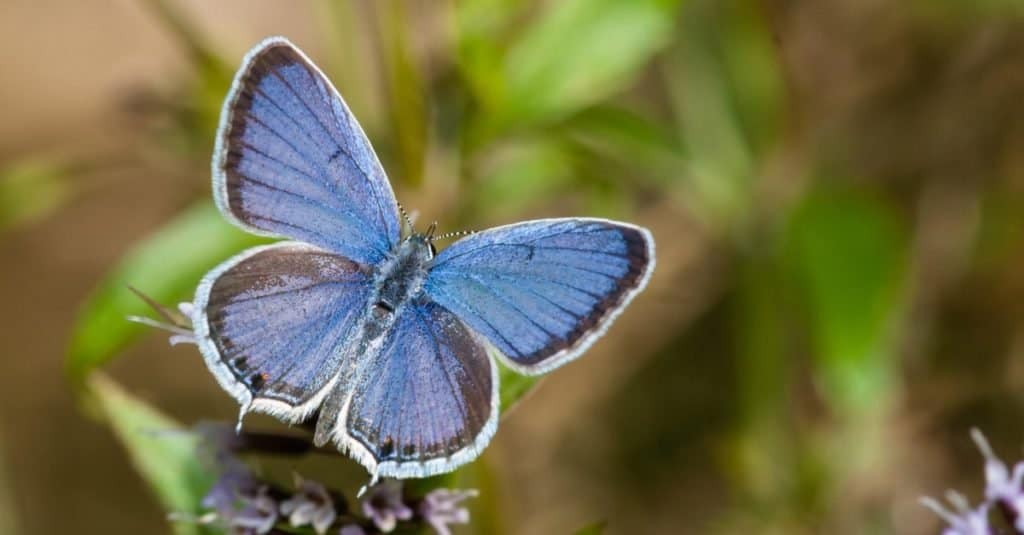
Male eastern tailed-blue have bright blue wings decorated with white lines on the edges and brown borders.
©Frode Jacobsen/Shutterstock.com
The eastern tailed-blue butterfly, also known as Cupido comyntas, is found in large numbers in California. The females and males have differently colored upper wings. It’s easy to tell the males apart from the females. The male butterflies have bright blue wings decorated with white lines on the edges and brown borders. The female butterflies have brownish-gray wings with white edges. However, both butterfly sexes have orange markings on their wing tails.
The wingspan of eastern tailed-blue butterflies ranges between 0.75 and 1 inch. You can quickly identify Cupido comyntas by its hair-like tail feature on its back wings. However, as butterflies can lose their wings, you will likely find some eastern tailed-blues with no tail. The butterfly’s habitat is pastures, home gardens, and empty lots in Northern California.
6. Great Spangled Fritillary
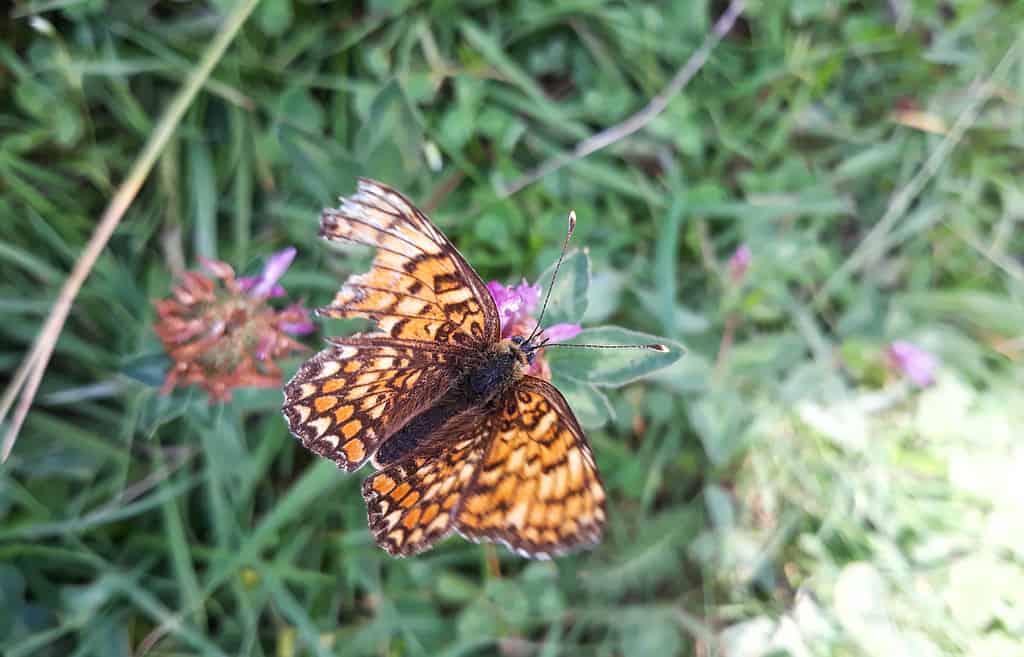
The great spangled fritillary butterfly features a web-like pattern on its wings.
©iStock.com/VALENTIN BUTARU
The great spangled fritillary butterfly has an orange coloring with black dots and lines that create a web-like pattern. The undersides of the butterfly’s wings have silvery white beads with black outlines. Like most butterflies in California, the great spangled fritillary enjoys sunny areas near meadows and pastures. If lucky, you might see hundreds of these butterflies in violet or milkweed fields.
The scientific name of the butterfly is Speyeria cybele. Its wingspan is 2.5 to 3.5 inches. The male dies almost immediately after mating, while the female dies after two or three weeks once it lays eggs.
7. Azure
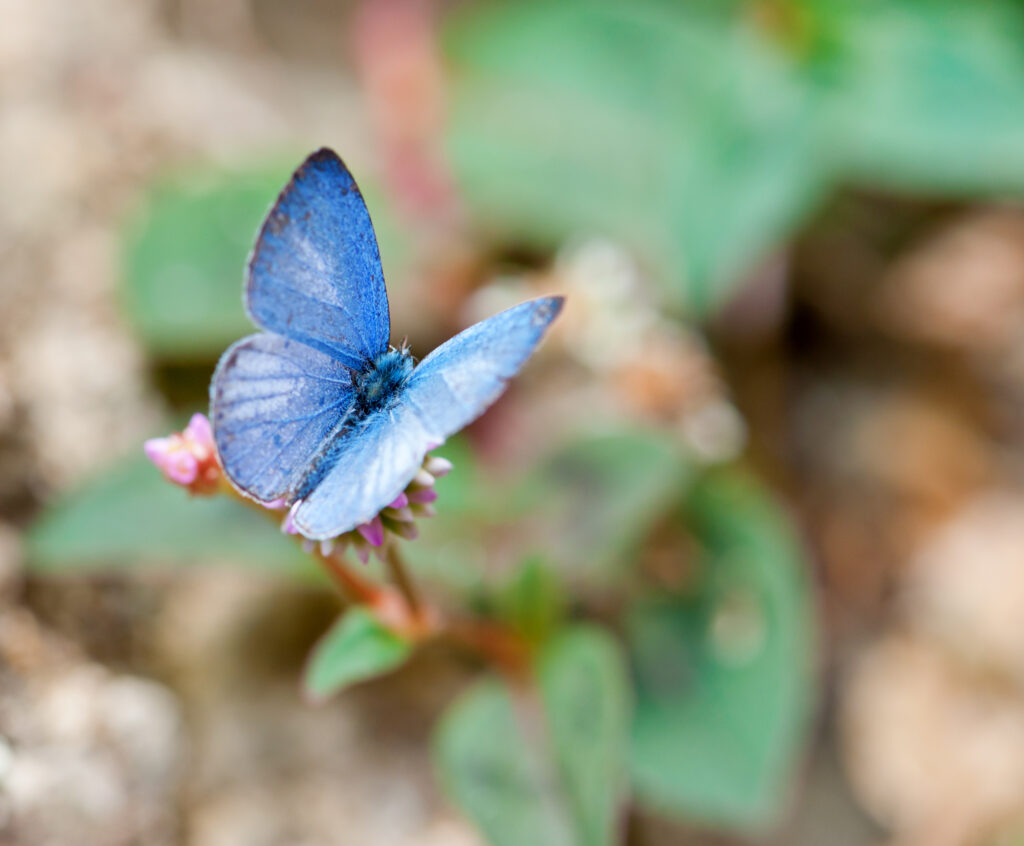
The azure butterfly is widespread in eastern California and easy to spot in spring.
©johannviloria/Shutterstock.com
The azure butterfly is commonly found in woodlands, hiking trails, forest edges, and roadsides in eastern California. The Azure butterflies are widespread and easy to spot in spring. The color of the butterfly’s wings ranges from dusky grayish to cornflower bluish tones with gray stripes and spots. However, females have darker, less colorful wings than males.
The wingspan of the butterfly is between 0.75 to 1.25 inches. The wings have a fabric-like fringed texture because the butterfly belongs to the gossamer-winged family species. The Azure butterfly is known scientifically as Celastrina ladon.
8. American Snout
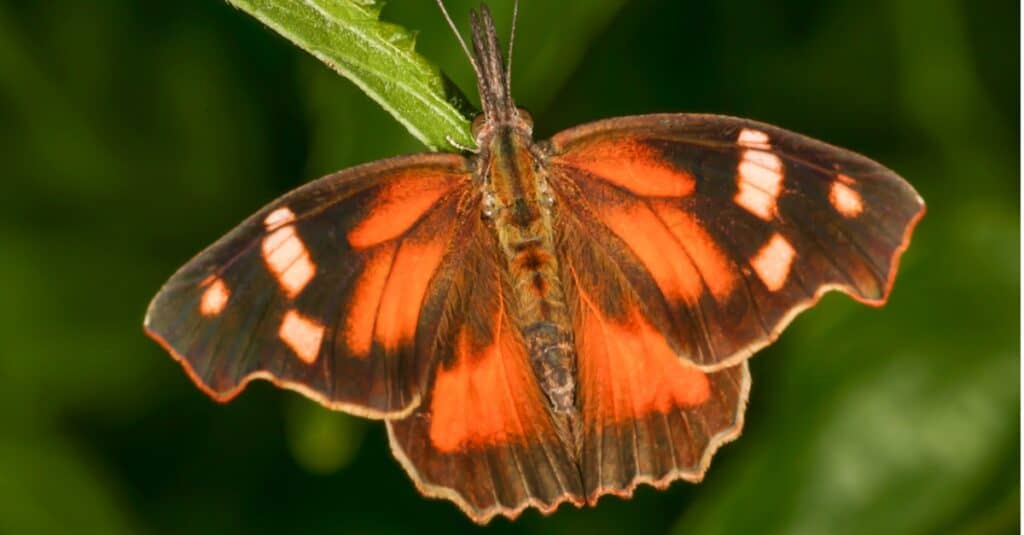
The American snout’s name comes from its long beaklike snout.
©iStock.com/EdwardSnow
Known scientifically as Libytheana carinenta, the American snout butterfly has a long beak-shaped feature used to camouflage and appear like a leaf. The butterfly has brown wings with a wingspan of about 1.5 to 2 inches. The wings have white and orange patches that make the American Snout butterfly resemble a dry, dead leaf. Moreover, the wings of the Libytheana carinenta species are dark with thick patterns on the upper side.
The butterfly may be hard to spot due to its impressive camouflage ability and hidden habitat. If you spot this species, it will likely be migrating with hundreds of other butterflies. The butterflies tend to drift north annually.
9. Black Swallowtail
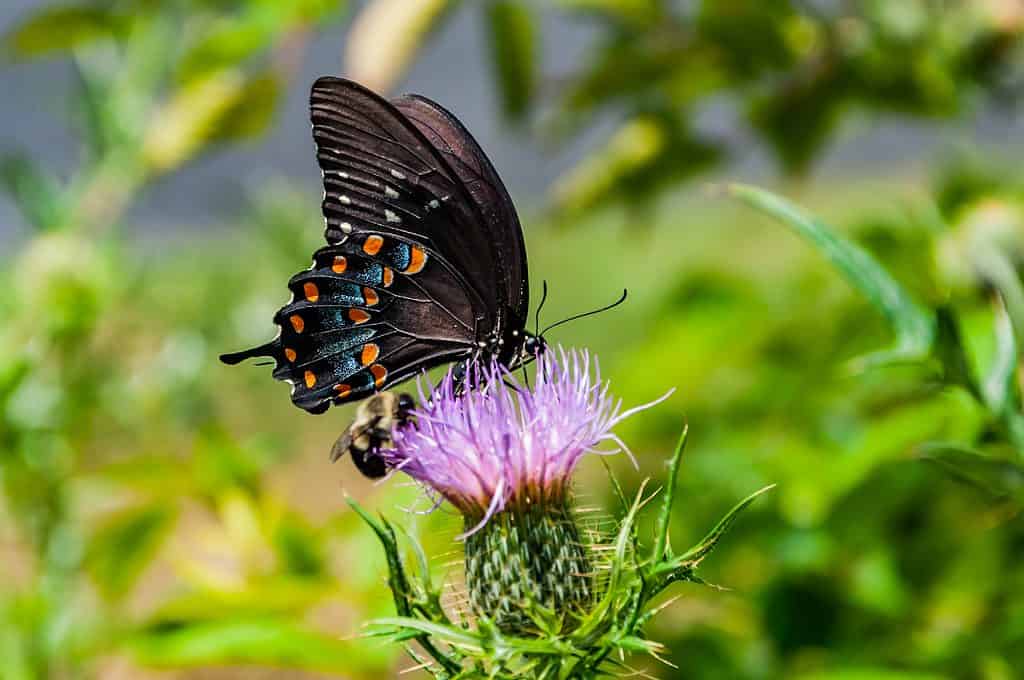
Black swallowtail butterflies are common in southern regions of California.
©Walt Bilous/Shutterstock.com
The black swallowtail butterfly, also called Limenitis archippus, is common in gardens throughout Southern California. The caterpillars of this species are green and have black bands that contain yellow dots across their backs. The caterpillars prefer to use herbal plants like mint and parsley as hosts.
The wingspan of the black swallowtail is 2.5 to 4.25 inches. The black wings have rows of yellow spots arranged in patterns. The butterflies also have orange and blue spots on their hind wings.
The spots on its wings are an evolutionary defense mechanism that allows the black swallowtail butterfly to hide in plain sight in the presence of its predators. The wing markings of this species are similar to the pipevine swallowtail, which is poisonous to most predators.
10. Orange Sulfur

Orange sulfur butterflies can be found in gardens and meadows.
©iStock.com/McKinneMike
The orange sulfur butterfly has an erratic flight pattern that’s easy to identify. The butterfly, known scientifically as Colias eurytheme, flies in a jerky manner close to the ground. It prefers the alfalfa plant as its host during the caterpillar stage. Adult butterflies feed on nectar from milkweed and clover flowers.
The wingspan of the butterfly is 1.5 to 2.5 inches long. Its bright yellow wings have irregular dark spots and black borders.
If you are a butterfly enthusiast, we recommend looking for the orange sulfur butterfly in abandoned gardens, meadows, and next to sunny roadsides during the spring and summer seasons.
11. Red Admiral
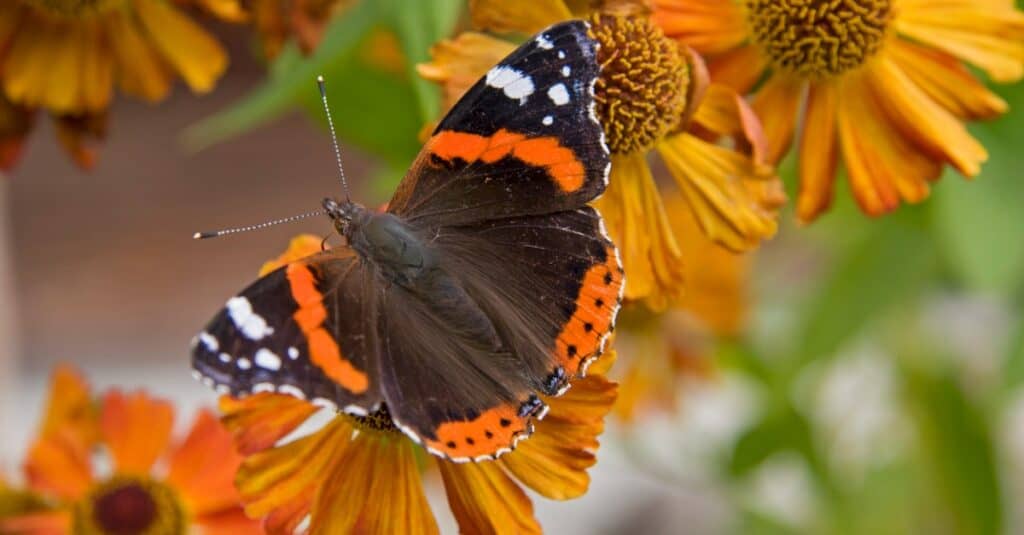
The red admiral is a migratory butterfly that may land on people near its habitat.
©iStock.com/Tinieder
The red admiral, also known as Vanessa atalanta, is one of California’s most widely spread butterflies. It is considered a migratory butterfly because it flies south to warmer regions in winter and flies back north during spring.
The red admiral butterfly is easy to observe because it’s calm and frequently lands on people near its habitat. The butterfly has dark brown wings that contain white spots and circular red bands, and a wingspan of 1.75 to 3 inches. The underside part of the back wings looks like the bark of a tree to assist with camouflage.
The caterpillars of this species have a coloring that ranges from pinkish gray to charcoal gray, with tiny white spots. Moreover, the caterpillars contain spikes that resemble hairs along their backs.
Unlike most butterflies that feed on nectar, the red admiral loves overripe fermented fruit. You can find these butterflies in moist areas along forest edges.
12. Monarch
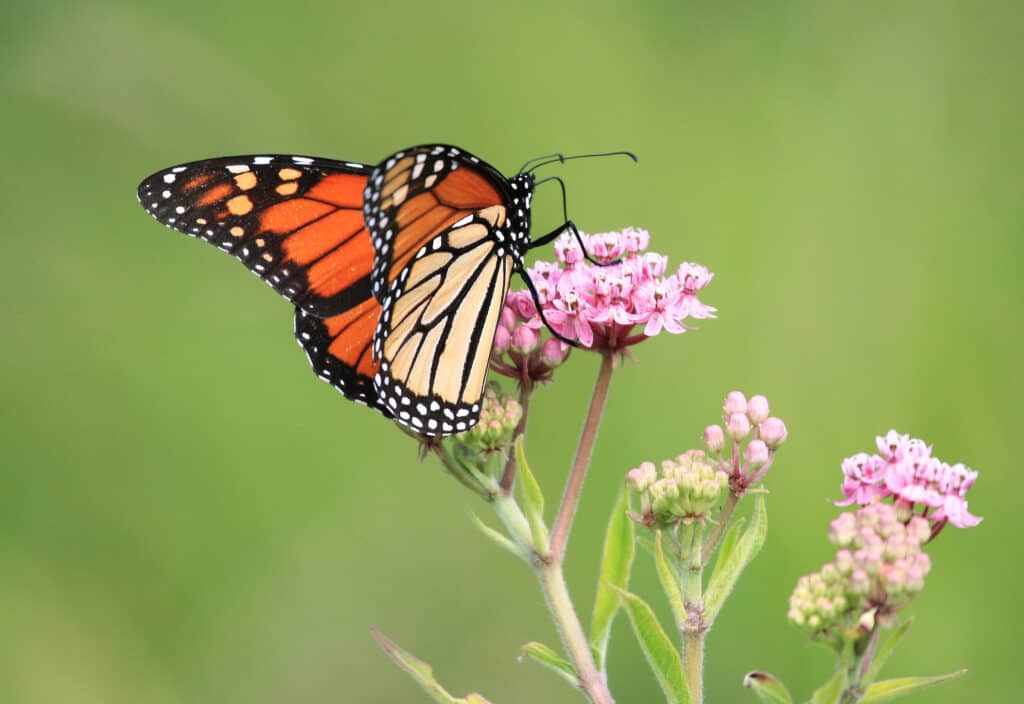
The
monarch butterfly
population is sadly declining in California.
©David Byron Keener/Shutterstock.com
The Monarch butterfly is one of the declining species of butterflies in California. Monarchs tend to migrate in mid-September towards the south. The butterfly has a stained glass orange coloring with black vein patterns that make it easy to recognize. The edges of the wings are lined with tiny white dots. The wingspan of the monarch ranges between 3.5 and 4 inches.
The caterpillars of this species are plump with thick bands that are yellow, black, and white, running across their bodies. Also, the caterpillars have many tentacles on each side of their bodies. Known scientifically as Danaus plexippus, monarch caterpillars feed only on milkweed plants.
13. The Painted Lady

Painted lady butterflies mates throughout the year, the only species to do so.
©Super Prin/Shutterstock.com
The painted lady butterfly is referred to scientifically as Vanessa cardui. The butterfly is known for being the only species that mate at any time during the year. The wings of the butterfly are pinkish or orange with broad patterns. The tips of the wings have brown or black markings and white dots in the middle. This species has a wingspan of around 2 to 3 inches.
The caterpillars have different colors ranging from charcoal brown to greenish-yellow with light-colored spots. Adult butterflies feed on nectar from various flowering plants, and the caterpillars feed on stinging nettles, mallows, and thistles.
You can look for the painted lady butterfly in quiet, undisturbed areas such as pastures and gardens in California. Due to its constant migration, this butterfly lays eggs in different habitats.
Fascinating Facts You Didn’t Know About Butterflies
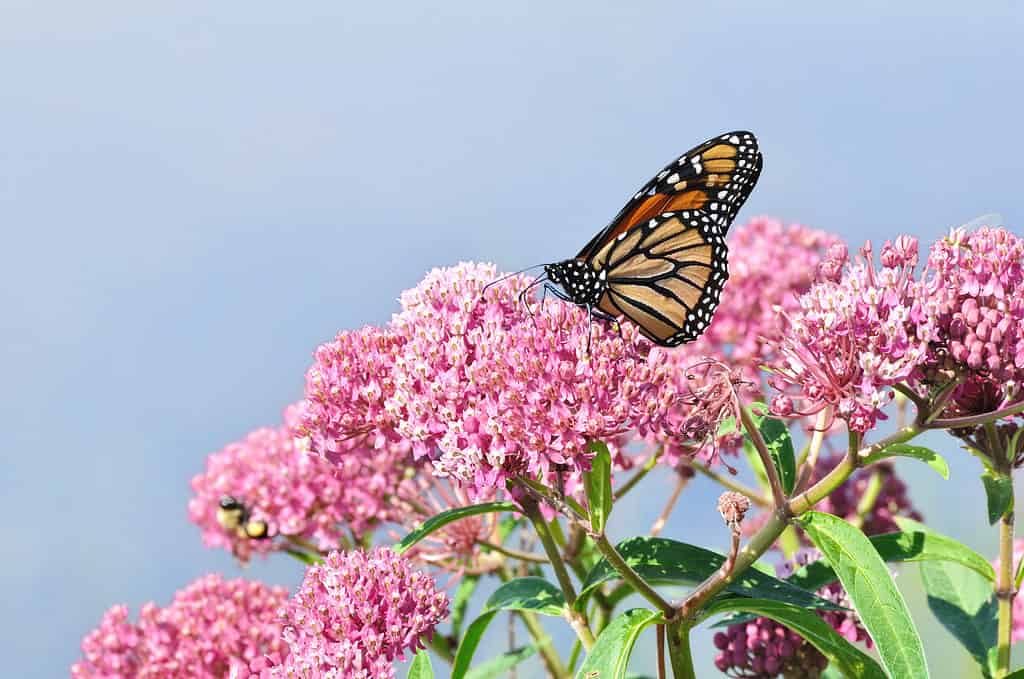
All butterflies have transparent wings colored in thousands of miniature scales.
©iStock.com/herreid
Butterflies are among the few insects that people appreciate due to their beauty. While butterflies may be pleasant to observe, there are many interesting facts about them that you probably didn’t know. Here are some facts about amazing butterflies that live in California.
Butterflies Have Transparent Wings
Although it may seem untrue, all butterflies have transparent wings. The wings are covered in thousands of miniature scales, which reflect the color of the wings. Butterfly wings are composed of chitin, a protein found in an insect’s exoskeleton. Chitin is transparent, which makes the wings transparent as well.
Butterflies Only Feed on Liquids
Butterflies survive on what is called a liquid diet. Although butterflies like to feed, they cannot eat solid foods because they don’t have the proper chewing apparatus. Butterflies feed using their proboscis, which allows them to draw nectar from flowering plants and juice from fruits.
Butterflies Use Their Feet to Taste
Has a butterfly ever landed on you? Chances are high that the butterfly was just hungry. A butterfly’s feet are significant because it uses them to land, mate, and eat. A butterfly’s feet contain taste receptors that allow it to identify the right plants to feed on. Therefore, butterflies can taste every surface they land on.
Butterflies Can’t Fly in the Cold
Butterflies are rendered immobile during cold temperatures. Despite being cold-blooded, a butterfly’s wings can only function with a high body temperature. Therefore, nature requires butterflies to maintain high internal temperatures to move around. As a result, butterflies tend to increase their body temperature by basking in the sun. If you observe butterflies frequently, you will notice that they prefer to lie still with their wings spread out to absorb as much warmth as possible from the sun.
Butterfly wings contain small capillary networks that transfer warmth from the sun into the blood, which is then transported to the rest of the body.
Butterflies Can See Colors the Human Eye Can’t
Did you know that butterflies can perceive ultraviolet light, which the human eye can’t see? Scientists also believe that the wings of some female butterflies are embedded with ultraviolet colors that attract males. Also, studies show that butterflies have more than 15 photoreceptors in each eye.
Summary of 13 Butterflies That Live in California
Here’s a recap of the 13 beautiful butterfly species we took a look at that can be found in the state of California.
| Number | Butterfly Species | Scientific Name | Wingspan |
|---|---|---|---|
| 1 | Variable Checkerspot | Euphydryas chalcedona | 1.3 to 2.2 inches |
| 2 | Gray Hairstreak | Strymon melinus | 1 to 1.5 inches |
| 3 | American Lady | Vanessa virginiensis | 1.75 to 2.5 inches |
| 4 | Mourning Cloak | Nymphalis antiopa | 3 to 4 inches |
| 5 | Eastern Tailed-Blue | Cupido comyntas | 0.75 and 1 inch |
| 6 | Great Spangled Fritillary | Speyeria cybele | 2.5 to 3.5 inches |
| 7 | Azure | Celastrina ladon | 0.75 to 1.25 inches |
| 8 | American Snout | Libytheana carinenta | 1.5 to 2 inches |
| 9 | Black Swallowtail | Limenitis archippus | 2.5 to 4.25 inches |
| 10 | Orange Sulfur | Colias eurytheme | 1.5 to 2.5 inches |
| 11 | Red Admiral | Vanessa atalanta | 1.75 to 3 inches |
| 12 | Monarch | Danaus plexippus | 3.5 and 4 inches |
| 13 | The Painted Lady | Vanessa cardui | 2 to 3 inches |
Butterflies Are Amazing
So many butterflies thrive in California that it would be impossible to describe them all. Also, butterflies enjoy warm climates, so California is, without a doubt, a suitable habitat. If you love observing butterflies, the list above will help you identify the most familiar butterflies in the state.
We recommend using wing color to identify and study different butterfly species. One great way to tell the difference between a male butterfly and a female butterfly is to check the size of the abdomen. A male butterfly has a slender abdomen, while a female butterfly has a bigger rounded abdomen.
For the best butterfly-watching experience, be sure to go out on warm and sunny days since butterflies tend not to fly when it’s cold.
Thank you for reading! Have some feedback for us? Contact the AZ Animals editorial team.

